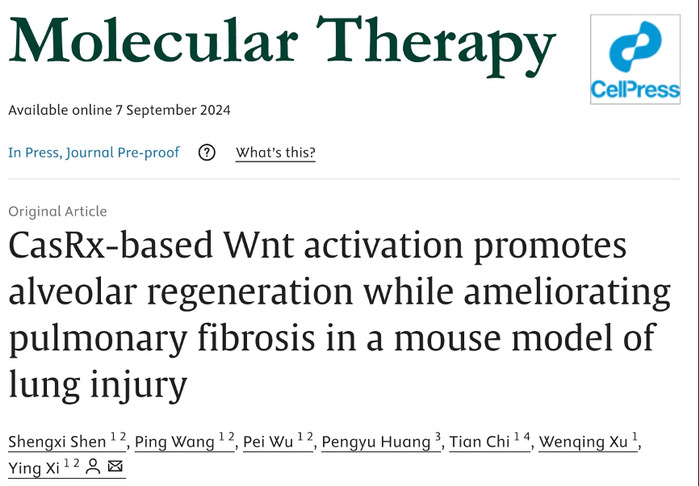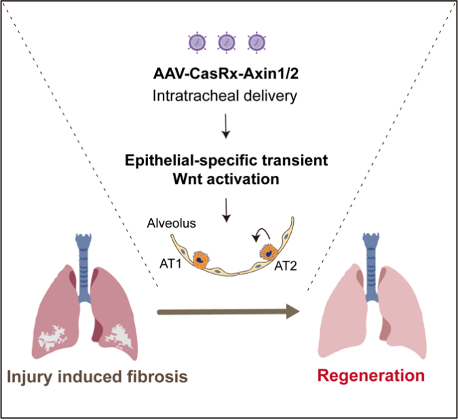Pulmonary fibrosis is a chronic progressive disease and a common end-stage pathological manifestation of various chronic lung conditions, with idiopathic pulmonary fibrosis (IPF) being the most prevalent. The onset of IPF is characterized by repeated epithelial cell damage, leading to impaired epithelial regeneration and activation of lung fibroblasts into myofibroblasts. This process results in excessive deposition of extracellular matrix, further damaging alveolar structure and impeding respiratory function. Currently, only two drugs, pirfenidone and nintedanib, are approved for treating IPF, and while they can slow disease progression, they do not cure or reverse it. Lung transplantation remains the only definitive treatment for IPF; however, limited donor resources, surgical complexity, and high costs restrict its widespread use. Consequently, effective therapies for IPF represent a significant unmet medical need.
The Wnt/β-Catenin signaling pathway plays a crucial role in tissue development, homeostasis maintenance, and regeneration. In adult tissues, this pathway maintains stem cell activity; however, its overactivation may lead to carcinogenesis. In adult lungs, Wnt/β-Catenin signaling promotes alveolar stem cell proliferation when injury occurs, facilitating epithelial barrier repair. Conversely, in fibroblasts, this pathway promotes fibroblast activation, contributing to pulmonary fibrogenesis. Thus, it is essential to activate the Wnt/β-Catenin signaling pathway transiently and in a cell-type-specific manner.
To address this challenge, a research team led by Assistant Professor Xi Ying from the School of Life Science and Technology (SLST) at ShanghaiTech University has developed a new strategy to promote lung regeneration and treat pulmonary fibrosis. Recently, their findings were published in the journal Molecular Therapy in an article titled “CasRx-based Wnt activation promotes alveolar regeneration while ameliorating pulmonary fibrosis in a mouse model of lung injury.” The research utilized an RNA editing system, CRISPR/CasRx, to knock down the scaffold protein Axin in the β-Catenin degradation complex, thereby specifically activating the Wnt/β-Catenin signaling pathway in lung epithelial cells. This activation promoted alveolar regeneration and inhibited pulmonary fibrosis in a mouse model.

In this study, the researchers employed the RNA editing component CasRx to knock down the scaffold protein Axin—including Axin1 and Axin2—in the β-Catenin degradation complex. This led to the stabilization of β-Catenin and activation of Wnt/β-Catenin signaling pathway. This editing tool was delivered to lung epithelial cells via an AAV6 vector through intratracheal injection, specifically activating Wnt/β-Catenin signaling pathway in lung epithelial cells without affecting other cell types. The results demonstrated that epithelial-specific activation of the Wnt/β-Catenin signaling pathway not only promoted alveolar regeneration but also effectively inhibited bleomycin-induced pulmonary fibrosis in both preventive and therapeutic mouse models. This study is the first to show that promoting alveolar stem cell proliferation can effectively treat pulmonary fibrosis, offering a new potential therapeutic approach for IPF.

CasRx-mediated Wnt signaling activation promotes alveolar regeneration and inhibits pulmonary fibrosis.
PhD candidate Shen Shengxi in Prof. Xi’s group is the first author of this paper, with Prof. Xi Ying serving as the corresponding author. ShanghaiTech University is the primary affiliation. SLST Professors Xu Wenqing and Chi Tian, along with Professor Huang Pengyu from the Institute of Biomedical Engineering at the Chinese Academy of Medical Sciences, also contributed to this research.
*This article is provided by Prof. Xi Ying.

